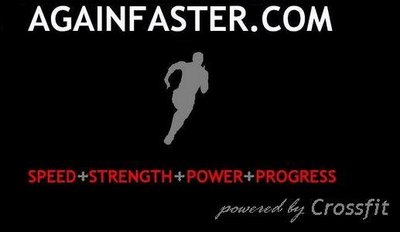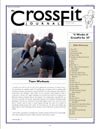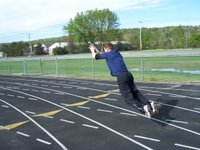
Here at Again Faster, we have a preoccupation with power. We measure our times, our repetitions, and our loads in an effort to calculate our athletic output to the nearest watt.
In the shot put, these calculations are unnecessary. Power output is evidenced by the farthest throw, an immediate visual measure that requires no pencils, paper, or formulas. The best athlete bombs the shot down the sector, and the gasp of the crowd is the only measure that matters.
Yesterday afternoon, I witnessed some of the best throwers in the world compete at the 2007 AT&T USA Indoor Track and Field Championships. The field was loaded, including two-time Olympic medalist John Godina, World Indoor Champion and #1 ranked Reese Hoffa, 2004 NCAA Indoor Champion Dan Taylor, and 2004 World Indoor Champion Christian Cantwell.
These guys are large, and they move fast. The massive indoor shot resembles a golf ball in the hands of these giants, and 65-foot throws are par for the course.
Reese Hoffa throws 69-plus.
The intricate footwork of world-class throwing puts incredible momentum on the shot, culminating in a drive and extension that sends the implement arcing outward at high speed. The violence of the throw is reminiscent of the third pull of the Olympic lifts, embodying the same devastating combination of speed and skill.
Cantwell continued his pursuit of the 75’10” world record with a Round One put of 71’3.5”, a throw that was unmatched for the rest of the competition. It was enough to secure him the men’s Visa Championship and a giant credit card worth $25,000, an enviable payday in the under-funded sport of professional track and field.
Hoffa took second with a 69’7” throw, and Taylor third with a 66’8” throw, neither man threatening Cantwell’s position at the top.
The final throw of the day belonged to Christian Cantwell. With the competition wrapped up, Cantwell stood in the ring, the shot extended overhead. The stands were shaking with the clapping of hundreds of spectators, the din reaching a crescendo as he lowered the shot to his neck and sank into his starting stance, beginning a blinding spin that culminated in the longest throw of the day.
Cantwell throws a bomb.
We screamed as the shot clanged off the backboards, only to see the official raise the red flag. The foul meant the throw would not be measured, despite the fact that it was easily over the 72’ mark. Cantwell would have to settle for his season-best mark of 71’9” and his gigantic check.
The applicability of throwing to elite fitness is obvious. Along with hip flexion and extension, throwing requires the athlete to harness rotational force to send an object as far as possible. Generating and maintaining rotational force requires tremendous strength throughout the torso, as the athlete must keep the body moving as a single unit throughout the throw. Any weak link severely compromises the end distance achieved.
We do not train the throws in the current Crossfit curriculum, perhaps to our own disadvantage. After witnessing the power and grace of the shot put, I believe that derivatives of the event could be useful in enhancing core strength, midline stabilization, and power expression, qualities that are perpetually lacking in our novice athletes.
John Godina in the ring.
Like every worthwhile athletic activity, power generation in the throws starts at the core and emanates outward, employing the largest muscles of the body in a multi-joint compound movement. We know from experience that this type of movement results in increased muscle mass, decreased body fat, and positive hormonal effects.
Given its similarities with our existing practices, incorporating throwing into the Crossfit training regimen is no-brainer. In fact, our preoccupation with power demands it.
Next time you wander in the door at Crossfit Boston, you may want to look to the sky—taking a shot to the head is never pleasant.
Go faster!
Lead picture of Dan Taylor.
























